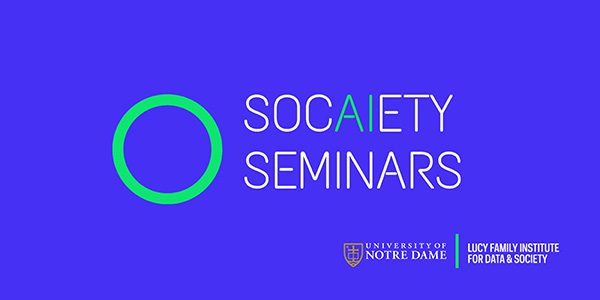Understanding the Body with W.B. Yeats & James Joyce – The Body in Irish History
Subscribe to the ThinkND podcast on Apple, Spotify, or Google.
Featured Speakers:
- Declan Kiberd, Emeritus Donald and Marilyn Keough Professor of Irish Studies and Professor of English and Irish Language and Literature
- Dr. O’Connor, HRHA, art historian, curator, lecturer, advisor, and archivist
The third session in the series Understanding the Body with W.B. Yeats and James Joyce was presented by Declan Kiberd, the Emeritus Donald and Marilyn Keough Professor of Irish Studies and a Professor of English and Irish Language and Literature at the University of Notre Dame. He was joined by Éimear O’Connor, an Art Historian, Curator, Lecturer, Advisor, and Archivist, and Lisa Caulfield, the Director of the Notre Dame Global Center at Kylemore Abbey, as the moderator. This session featured a discussion on the human body throughout Irish history, especially focusing on women and the repression of sexuality in the post-famine era. Kiberd explored the phase in Yeats’ writings in which he explored the connection between the body and the mind and questioned society’s separation of them. The session also included biblical connections, discussions on Catholic Church teachings, and various paintings depicting the topics covered.
Kiberd again began the session by giving a brief overview of the topic. He emphasized the repression of sexuality in the post-famine culture of Ireland and the roots of this repression that were found in the Catholic Church. He also highlighted the use of the female voice by various Irish writers during this era. These women characters were similar to each other but dissimilar to the modern woman in society, a woman who was only appreciated as a submissive wife and mother. O’Connor then contributed her thoughts on the topic by showing various artistic representations of the Virgin Mary and Saint Elizabeth at the Visitation. She discussed how the models used for paintings at this time were usually considered degenerate in society, illustrated by the fact that the characters in the paintings were dressed in very ordinary clothing. She also discussed why there are few renditions from the time period with the pregnant Virgin Mary. Because all religious paintings at the time were commissioned by the Catholic Church, the painters were instructed to illustrate Mary without her pregnant body to emphasize her saintliness.
Kiberd then moved to further discuss the repression of sexuality in Irish culture. He believed that the Irish Potato Famine had a traumatizing effect on the Irish people’s trust in nature, leading to a mistrust of their bodies as creations of nature. Because they no longer saw the beauty in their bodies, they repressed their sexuality and were afraid of discussing it openly. In response to this, various Irish writers such as Joyce and Yeats began to question the disconnection of the mind and the body, as well as the complete dependence on the teachings of the Catholic Church in Irish society. O’Connor echoed her agreement with the positive effects of these writers on the modernization of Irish culture, saying that they were wildly successful in instigating the change they sought. The two panelists also discussed at length an interview that took place on the Late Late Show in 1993 with Annie Murphy, a young lover of Bishop Eamonn Casey, who was questioned at length about her pregnancy resulting from the affair. O’Connor expressed her thoughts on this interview and explained how it was a turning point for her in realizing the deep chasms in Irish culture caused by the separation of mind and body and the spiritual and sexual. The session concluded with participant questions on the symbolism of female characters in Irish literature, interpretations of the art shown by O’Connor and the effects of the Annie Murphy interview on the modernization of Irish society.
- The art produced by artists from a specific time period can depict the societal beliefs of the era. (16:02)
- Women in historical Irish paintings were either depicted as saints or degenerates. There was no character in between, and the women were dressed like one or the other. (16:30)
- After the Irish Potato Famine, the Irish people lost their respect for nature. This manifested itself in a distrust of their own bodies and sexuality, which was not overcome until decades later. (19:02)
- Irish authors such as Joyce and Yeats contributed to the re-liberalization of the Irish society by using their writing to question the proliferation of Catholic beliefs and the repression of women. (31:52)
- Ireland has emerged from its troubled history as a very forward thinking country, illustrating the fact that the history of a country plays a pivotal role in its current culture and identity. (33:23)
- “It is not the written word that impairs memory, but dependence on the written word to the exclusion of the spoken. Some experience cannot be put wholly into writing. And so as dependence on writing grows, the communicated experience suffers a corresponding attenuation.” (Nuala Ní Dhomhnaill, 6:13)
- “It’s interesting to me that so many Irish writers like Yeats, when they reach middle age, write in the female voice. You have Joyce’s Molly, Beckett’s Winnie. It’s as if when they achieve a level of success and self-confidence and relaxation, they’re suddenly able to give voice to the woman within.” (Declan Kiberd, 7:29)
- “Because the Catholic Church is commissioning, there is no pregnant Virgin Mary, and this whole idea of the saint or the slut becomes even more embedded in the psyche of the way we are thinking.” (Éimear O’Connor, 16:26)
- “I feel that the distrust of nature which morphed into a distrust of sexuality, happened because the people had trusted nature, they’d trusted the potato, and it let them down.” (Declan Kiberd, 17:44)
- “The history of our art and culture is as important as now, our contemporary art and culture, to our identity and the way we see ourselves moving forward.” (Éimear O’Connor, 33:23)
Related Content
Climate Change and The Limits of Narrative
Join the Kellogg Institute for the introductory session of a workshop refining Kellogg Faculty Fellow Roy Scranton’s draft book project “Ethical Pessimism: Climate Change and...
View EventReunion 2024
Alumni Education Programming Click each program title to learn more. To return to the Reunion 2024 website on my.nd.edu please click here. ND Perspectives: Election 2024 and the...
Read ArticleA Brave New World of AI Governance
Explore the connection between data, geopolitics and governance, regulation, self-regulation while discovering examples of good and bad practices in various sectors, such as...
View Event


